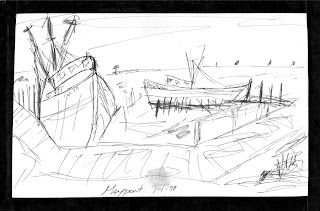
By the end of January, 31 years ago, I had been working at St. Augustine Trawlers for about a week and already had been struck with a deep romantic affection for the steep bows, sweeping sides and broad flat transoms. As a shipping clerk, my clip board was my passport to every corner of the boatyard. With it and pen, I could wander and appear to be checking inventories while really just watching the work of hundreds of men each doing something very specific all with a single objective: to build a boat.
Over the next seven months I watched wooden hull trawlers, or shrimp boats as they were most commonly called because that’s what they were built to catch, slide from the airplane-hanger like building, little more than a three story high shed open on the east and west ends, down parallel rails and into the San Sebastian River at the rate of one a week. It was the height of St. Augustine's boat building boom.

First the keel was built lying on its side, carved from multiple blocks of wood two and a half feet square, pieced together, and locked into place like a giant Lincoln log. It was then righted and hung from the rafters of the shed where over the next month the ribs and the sides were hammered into place by men with hammers, real hammers. The engine room and storage rooms were partitioned off below and the deck laid out above. The wheel house and transom, built separately, were swung into place and made one with the hull.
It was then that the boat was rolled out and down the rails, bouncing in the water like an empty bottle with no weight to hold it down; at least until the bright yellow Caterpillar engine and jet black wrench and rigging were loaded. Then it steadied and settled. Soon after the engine was started for the first time and trial runs up and down the river completed, the trawler left never to return, headed for bays and backwaters up and down the southern Atlantic and all along every side of the Gulf.

There was little to distinguish one trawler from another: same size and shape, same color, same rigging. What made each distinctive was its name and its port of call. These I would learn when a painter would suspend a scaffold from the transom and in big black block letters spell a name and a port: Constance/Aransas Pass; Miss Trudy/Brownsville; Southern Sea/Beaufort; Bella Rio/Bluefields. Until there was a name, the boat had no identity; until it had a port, it had no home.
I never rode on a trawler, but I never see one that I do not see through to its heart and wonder where it was built and who swung the hammers and who painted the name.

[Photos:(from top down) Sketch of trawlers docked on the St. Johns River at Mayport, Florida, January 1, 1978; fuel tank at site of now closed St. Augustine Trawlers; trawler on the San Sebastian River, August 2007; painting on the now demolished Fazio's Seafood building on the San Sebastian River at King Street.]